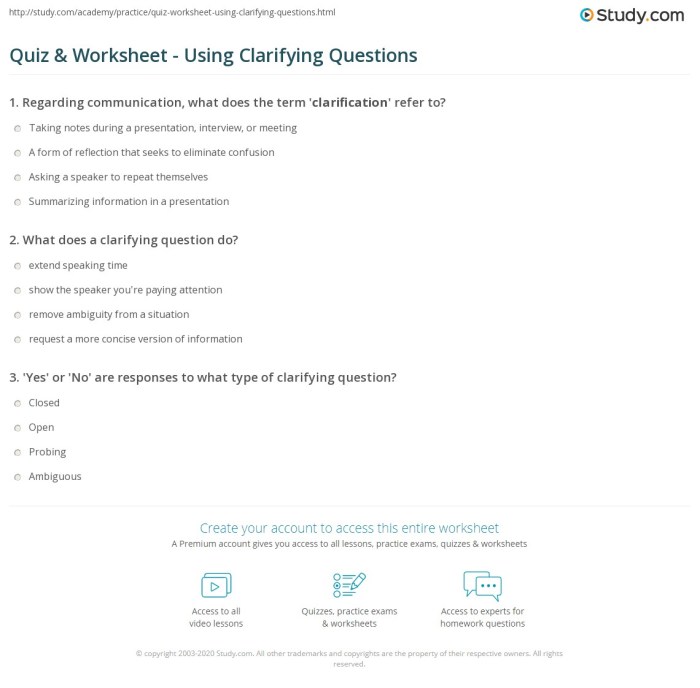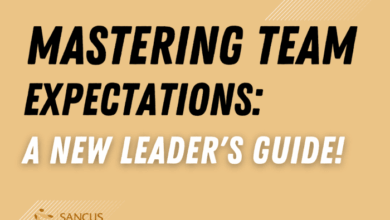
Simple one on one questions that pack a punch are the key to unlocking deeper connections and insightful conversations. This post dives into crafting effective questions for various contexts, from personal growth to professional interviews. We’ll explore how the right phrasing and structure can transform ordinary interactions into engaging and meaningful dialogues. Get ready to learn how to ask questions that truly matter.
From relationship building to problem-solving, we’ll categorize different question types and explore their purposes. We’ll also discuss the importance of tailoring your questions to the specific situation and individual. Learn how to create questions that encourage in-depth responses and avoid superficial ones. Visual aids, like flowcharts and diagrams, can significantly enhance your interactions and make complex ideas more accessible.
Defining “Punchy” Questions
A punchy question isn’t just any question; it’s a carefully crafted inquiry designed to spark intrigue, elicit insightful responses, or drive a conversation forward. It’s more than simply asking a question; it’s about strategically framing the query to maximize its impact. This approach is crucial in various contexts, from job interviews to personal growth discussions.Punchy questions, unlike ordinary ones, go beyond surface-level inquiries.
They delve deeper, prompting reflection, critical thinking, and a more nuanced understanding of the subject matter. Their power lies in their ability to move beyond simple answers to explore underlying motivations, perspectives, and potential solutions.
Characteristics of Punchy Questions
Punchy questions possess several key characteristics that distinguish them from their less impactful counterparts. These attributes contribute to their ability to elicit meaningful responses and drive engagement.
- Clarity and Precision: A punchy question is unambiguous and clearly defined. It leaves no room for misinterpretation and focuses the respondent on a specific area of inquiry. Examples include: “What specific skills do you feel you’ve developed that directly address the requirements of this position?” or “What is the core issue that prevents you from achieving this goal, and how can you actively address it?”.
- Relevance and Context: A punchy question is relevant to the specific situation or discussion. It builds on previous points, acknowledges prior responses, and guides the conversation towards a deeper understanding. For instance: “Given your experience with [specific project], how would you approach a similar challenge with [new aspect]?” or “Considering your recent feedback on the team’s performance, how can we best utilize individual strengths to address future obstacles?”
- Probing and Thought-Provoking: Punchy questions aren’t just designed to elicit a simple yes or no. They encourage critical thinking, analysis, and a more in-depth exploration of the subject matter. Questions such as “What are the potential long-term consequences of this decision?” or “How might we approach this challenge from a completely different perspective?” demonstrate this characteristic.
Phrasing and Structure
The phrasing and structure of a question significantly impact its effectiveness. A well-structured question guides the respondent towards a desired response and avoids ambiguity. Consider the following examples:
- Open-ended questions: These questions encourage detailed responses and explore a wide range of perspectives. “What are your thoughts on the recent market trends?” or “What motivates you to pursue this career path?”
- Probing questions: These questions delve deeper into a topic or response, seeking further clarification or additional information. “Can you elaborate on the specific strategies you employed?” or “What other factors might be influencing your decision?”
- Hypothetical questions: These questions explore potential outcomes or scenarios, fostering strategic thinking. “If you were faced with this unexpected challenge, what steps would you take?” or “If you had unlimited resources, how would you approach this problem?”
Evaluating Punchiness
A framework for evaluating the “punchiness” of a question can be developed based on several criteria. This framework allows for a more systematic and objective assessment of a question’s effectiveness.
| Criteria | Description |
|---|---|
| Clarity | Does the question clearly define the desired information? |
| Relevance | Is the question relevant to the current context or discussion? |
| Probing Depth | Does the question encourage thoughtful analysis and reflection? |
| Impact | Does the question inspire engagement and meaningful dialogue? |
Identifying One-on-One Question Types: Simple One On One Questions That Pack A Punch

Asking the right questions is crucial for any meaningful interaction. Effective questions go beyond simple answers; they unearth deeper insights, foster understanding, and pave the way for productive conversations. This is especially true in one-on-one settings where personal connections and problem-solving are key. Understanding the different types of questions available and their respective purposes empowers us to tailor our approach for optimal impact.Effective one-on-one conversations are more than just exchanges of information.
They’re about building relationships, solving problems, and fostering learning. Different question types serve specific purposes within these conversations. Mastering these types allows us to guide conversations toward valuable outcomes and ensure that every interaction contributes meaningfully to the overall connection.
Simple one-on-one questions can be surprisingly powerful conversation starters. For example, checking out the latest tech releases, like at the Nokia expo, which is showcasing fresh phones and Facebook features, Nokia Expo ushers in fresh phones and Facebook features , really sparks interesting discussion points. Ultimately, these kinds of engaging questions are key to building genuine connections.
Relationship-Building Questions
Relationship-building questions focus on creating a deeper connection by understanding the other person’s interests, values, and motivations. These questions move beyond superficial inquiries and delve into the individual’s core passions and beliefs. Their impact lies in fostering trust, empathy, and mutual understanding.
- Understanding Interests: Questions like “What are you most passionate about?” or “If you could have any superpower, what would it be and why?” tap into intrinsic motivations, providing insights into the individual’s values and aspirations. This type of question creates an opening for shared experiences and fosters a more personal connection.
- Exploring Values: “What are your core values?” or “What principles guide your decisions?” help to uncover the individual’s guiding principles. This allows for deeper understanding and recognition of shared values, strengthening the bond between individuals.
- Discovering Perspectives: Questions like “What’s something you’re proud of accomplishing?” or “What’s a challenge you’ve overcome?” can open up a dialogue about personal experiences, helping to create a more empathetic understanding.
Problem-Solving Questions
Problem-solving questions are designed to uncover the root causes of issues and identify potential solutions. They’re crucial in navigating disagreements, resolving conflicts, and finding practical solutions. These questions help to move beyond surface-level complaints and delve into the underlying issues.
- Identifying Challenges: “What are some of the challenges you’re facing?” or “What are the biggest obstacles you’re currently dealing with?” encourage the individual to articulate their difficulties. This clarity is essential for effective problem-solving.
- Understanding Perspectives: “How do you see this situation?” or “What are some potential solutions you’ve considered?” allow for the exploration of different viewpoints and strategies. This diverse perspective is valuable in generating effective solutions.
- Focusing on Solutions: “What steps could you take to address this issue?” or “What resources might be helpful in finding a solution?” encourage the individual to actively participate in finding a solution. This empowers the individual and ensures a collaborative approach.
Learning Questions
Learning questions are designed to facilitate knowledge acquisition and skill development. These questions prompt reflection, critical thinking, and deeper understanding. They are essential for educational settings, mentorship, and personal growth.
- Encouraging Reflection: “What did you learn from this experience?” or “How can you apply this knowledge in the future?” prompt individuals to reflect on their experiences and extract valuable lessons.
- Promoting Critical Thinking: “What are some alternative perspectives on this topic?” or “What are the potential consequences of this action?” encourage individuals to analyze information from multiple angles, fostering critical thinking and decision-making skills.
- Facilitating Growth: “What are some areas where you’d like to improve?” or “What skills do you want to develop further?” prompt self-awareness and focus on personal growth. These questions empower individuals to set goals and actively pursue their development.
Tailoring Questions to Specific Situations
Effective one-on-one interactions require tailoring questions to the specific situation and the individual involved. A question that works well in a casual conversation might be inappropriate in a formal setting. Similarly, a question effective with a seasoned professional might not resonate with a newcomer. Understanding the context and the individual’s needs is paramount for generating meaningful and impactful interactions.
Question Types Table
| Question Type | Purpose | Example | Impact |
|---|---|---|---|
| Relationship Building | Foster connection and understanding | “What are your hobbies, and what do you enjoy most about them?” | Creates a deeper connection by exploring shared interests. |
| Problem Solving | Uncover underlying issues | “What are the contributing factors to this issue, in your opinion?” | Promotes a deeper understanding of the problem and its roots. |
| Learning | Facilitate knowledge acquisition and skill development | “What is your perspective on the current market trends?” | Encourages critical thinking and learning by exploring diverse perspectives. |
Crafting Effective Question Structures
Asking insightful questions is a crucial skill for fostering meaningful conversations and eliciting rich responses. Effective questioning goes beyond simple inquiries; it involves strategically crafting questions that encourage deep thought, promote engagement, and lead to productive dialogue. This process requires understanding the nuances of question structure and the power of follow-up.Beyond basic inquiries, crafting questions that delve deeper into a topic or perspective is essential for a rich discussion.
Simple one-on-one questions can be surprisingly powerful tools. Think about how probing inquiries can reveal deeper insights. For example, recent news about Microsoft’s potential to patent high tech snoop software here raises serious privacy concerns. Ultimately, mastering the art of asking effective questions remains crucial, regardless of the tech giants’ intentions.
This involves moving beyond surface-level answers and encouraging participants to explore their thoughts and ideas more thoroughly. The following sections will demonstrate how to construct questions that encourage in-depth responses, provide examples of effective questioning techniques, and offer guidelines for crafting open-ended questions that stimulate discussion.
Constructing Questions for In-Depth Responses, Simple one on one questions that pack a punch
To encourage in-depth responses, questions must go beyond simple yes/no answers or brief summaries. They should prompt reflection and exploration of underlying concepts. A key element is avoiding leading questions that suggest a specific answer. Instead, focus on open-ended inquiries that allow for a range of perspectives.
Examples of Questions Eliciting Insightful Answers
- Instead of: “Do you like the new product design?” Try: “What aspects of the new product design resonate most with you, and why do you feel that way?” This encourages a deeper exploration of the respondent’s reasoning.
- Instead of: “What is your opinion on the proposed budget cuts?” Try: “Considering the potential impact on various departments, how might the proposed budget cuts affect the overall efficiency and sustainability of the organization?” This prompts a more comprehensive understanding of the issue.
- Instead of: “What is your favorite feature of the project?” Try: “What specific aspects of the project do you feel contributed most significantly to its success, and how did these aspects interact with each other?” This encourages the respondent to analyze and connect different elements of the project.
Crafting Open-Ended Questions for Discussion
Open-ended questions are vital for fostering discussion and encouraging a range of perspectives. They allow participants to elaborate on their thoughts, share different viewpoints, and build upon each other’s ideas.
- Questions should be phrased in a way that invites multiple interpretations and responses. Avoid questions that can be answered with a simple “yes” or “no.”
- Encourage participants to consider different angles and viewpoints. For example, instead of asking “What do you think about X?”, try “From a historical perspective, how might X have evolved?”
- Frame questions that encourage exploration of underlying assumptions. For instance, instead of asking “Why do you think X is important?”, try “What assumptions are you making about X, and how might those assumptions impact our understanding of the issue?”
Phrasing Questions to Spark Curiosity and Engagement
The way a question is phrased significantly impacts its effectiveness. Crafting questions that pique curiosity and encourage active participation is key.
- Use evocative language to create a sense of intrigue and stimulate interest. Avoid overly technical or jargon-laden language.
- Pose questions that challenge assumptions and encourage critical thinking. Frame questions that invite participants to consider alternative perspectives.
- Employ rhetorical questions to spark discussion and encourage reflection. These questions do not require direct answers but encourage a dialogue around the topic. For example, “If we were to consider the long-term consequences, how might our current approach impact future generations?”
Utilizing Follow-Up Questions to Maintain Conversation Flow
Follow-up questions are crucial for maintaining the flow of conversation and ensuring a comprehensive understanding of the topic. They allow for clarification, exploration of details, and deeper engagement.
- Listen attentively to the initial responses and formulate follow-up questions based on the content of those responses. This demonstrates active listening and interest in the speaker’s perspective.
- Ask clarifying questions to ensure that you understand the respondent’s point of view completely. For example, “Can you elaborate on that?” or “Could you provide a specific example?”
- Probe deeper into the respondent’s reasoning by asking questions that encourage further reflection. For example, “What led you to that conclusion?” or “What are the potential implications of that choice?”
Utilizing Visual Aids for Impact
Visual aids can significantly enhance one-on-one interactions by making complex information more accessible and memorable. They provide a tangible representation of ideas, facilitating a deeper understanding and engagement from both parties. A well-chosen visual can transform a potentially dry discussion into a dynamic and productive exchange.
Enhancing One-on-One Interactions with Visual Aids
Visual aids offer a powerful tool to amplify the impact of one-on-one conversations. A clear and concise visual representation can bridge communication gaps, especially when dealing with abstract concepts or intricate processes. Tables, diagrams, and flowcharts are particularly useful in clarifying information and showcasing the relationships between different components of a discussion.
Visual Aid Types and Their Applications
The table below illustrates various visual aid types and their intended purposes. Understanding the specific purpose of each aid is crucial for effective integration into the conversation.
| Visual Aid | Purpose | Example |
|---|---|---|
| Flowcharts | Illustrate the progression of a discussion or process. They clearly define the steps involved and the potential outcomes. | A flowchart showing the steps in a problem-solving process, from identifying the issue to implementing a solution. |
| Diagrams | Represent complex information visually, often highlighting relationships and dependencies. | A diagram illustrating the different aspects of a project, such as the tasks, timelines, and team members involved. |
| Charts (e.g., bar charts, pie charts) | Present data in a concise and easily understandable manner. | A bar chart comparing sales figures for different product lines. |
Incorporating Visuals Effectively
To integrate visuals effectively, introduce them strategically during the conversation. Don’t simply display the aid and leave it there; instead, explain how it relates to the current point being discussed. Explain the key elements and their significance. This active engagement keeps the conversation dynamic and focused.
Illustrating Points with Visuals
Visuals are not mere decorations; they are powerful tools to reinforce the points raised during the discussion. For example, if discussing a project’s timeline, a Gantt chart can illustrate the critical path and potential delays. A diagram of a process can highlight potential bottlenecks or areas for improvement. Visuals transform abstract ideas into concrete examples.
Simple one-on-one questions can be surprisingly powerful tools. For example, think about how crucial website speed is in today’s fast-paced world. Understanding how quickly a site loads, especially when seconds count, is vital for user experience and business success. Check out this insightful article on web site performance when seconds count to learn more. Ultimately, these seemingly simple questions can reveal a lot about your target audience and help you make informed decisions, just like knowing your site’s performance can improve your strategy.
Scenario: Project Planning
Imagine a discussion between a project manager and a team member regarding a new project. The project manager wants to ensure the team understands the project’s phases and dependencies. A flowchart illustrating the project’s phases, from initiation to completion, with arrows indicating dependencies between phases, can clearly convey the project’s progression. A table showcasing assigned tasks and deadlines, along with a visual representation of the project timeline, will help the team member visualize their role and the overall project scope.
Selecting Appropriate Visuals
Choosing the right visual aid is paramount. The visual aid should be directly relevant to the topic being discussed. An irrelevant visual can distract from the conversation and confuse the recipient. Consider the audience’s knowledge level and the complexity of the information being presented when selecting the appropriate visual. For example, a simple bar chart is sufficient for presenting sales figures, whereas a more complex network diagram might be needed to illustrate the interconnectedness of different systems.
A visual aid should enhance, not obscure, the conversation.
Example Applications
Punchy questions, when applied strategically, can significantly enhance one-on-one interactions, whether in professional or personal settings. They move beyond surface-level discussions to delve into deeper understanding and actionable insights. This section explores various scenarios where these techniques shine.Effective one-on-one interactions often hinge on the ability to quickly grasp the core issues and challenges. Punchy questions, designed to elicit precise responses and drive meaningful dialogue, can be invaluable tools for achieving this.
The examples below highlight diverse applications of this approach.
Scenarios for Effective Use
The application of punchy questions is not limited to a single setting. Their effectiveness depends on tailoring the questions to the specific context and audience. Consider these scenarios:
- Performance Reviews: Instead of asking “How was your performance this quarter?”, a punchy question might be “What specific actions did you take that demonstrably exceeded expectations, and what could you do to further optimize those results?” This focuses the review on concrete examples and encourages proactive thinking.
- Conflict Resolution: A punchy question, such as “What are the underlying needs and concerns driving this disagreement?”, helps move beyond surface-level complaints to identify the root causes and potential solutions.
- Sales Conversations: Rather than asking “Are you interested in this product?”, a punchy question could be “What are the key pain points your company faces that this product directly addresses?” This encourages the prospect to articulate their needs and positions the product as a solution.
- Personal Relationships: “What specific actions could we take to strengthen our connection and address any unresolved feelings?” helps to initiate meaningful conversations about improving communication and intimacy.
Case Study: Improving Team Collaboration
A project manager noticed decreased team productivity. Instead of generic feedback, the manager used a series of punchy questions, like “What specific roadblocks are preventing the team from completing tasks efficiently?” and “What tools or resources would help you overcome those obstacles?”. These focused questions led to identifying a lack of clear communication protocols and insufficient access to crucial project documents.
By addressing these specific issues, the team implemented improved communication channels and centralized document management, resulting in a 20% increase in project completion rate within two months.
Creating Compelling Questions
Developing effective questions requires careful consideration of the audience and the desired outcome.
- Audience Analysis: Understanding the audience’s background, knowledge level, and motivations is crucial. Tailor the question’s complexity and language accordingly.
- Desired Outcome: Determine the specific information or insight you seek from the response. A clear objective will guide the wording of the question.
- Clarity and Specificity: Avoid ambiguity and jargon. Use precise language and focus on a single, clear point.
- Open-Ended vs. Closed-Ended: Choose the type of question that best suits the desired response. Open-ended questions encourage deeper discussion, while closed-ended questions help to clarify specific details.
Example Question Series: Improving Project Management
To guide a discussion on improving project management, a series of punchy questions could be employed:
- What specific project phases are consistently experiencing delays?
- What resources are insufficient for timely completion of these phases?
- What alternative methodologies could be implemented to streamline these processes?
- What metrics can be used to effectively track and measure improvements?
- How can the team’s communication protocols be refined for greater efficiency?
Final Wrap-Up

In conclusion, mastering simple one-on-one questions that pack a punch is a powerful skill for any interaction. By understanding the different types of questions, their structures, and how to use visual aids, you can significantly improve the depth and impact of your conversations. Remember to tailor your approach to the specific situation and individual. Armed with these insights, you’ll be well-equipped to spark meaningful dialogues and achieve your desired outcomes.






